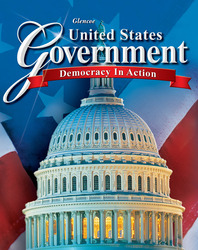United States Government: Democracy in ActionChapter 14:
Citizenship and Equal JusticeChapter Overviews[logo] Essential Question
How has the United States been shaped by its immigrant history, and how do we determine the rights of citizenship? Section 1 A Nation of Immigrants
The Constitution gives Congress the power to make immigration policy. The first major law on immigration—the Chinese Exclusion Act—was passed in 1882. Some 25 million immigrants arrived between 1880 and 1920, mostly from southern and eastern Europe. Congress passed the Immigration Act of 1924 to introduce a quota system and reduce immigration. The quota system was abolished in 1965 when Congress passed the Immigration Reform Act. President Reagan's Immigration and Reform Control Act punished employers who hired undocumented immigrants and also granted amnesty to long-term undocumented immigrants, allowing them to apply for citizenship. The debate over immigration policy continues. Section 2 The Basis of Citizenship
The Founders assumed that the states would decide who was or was not a citizen. The Fourteenth Amendment changed that. It set forth two bases for U.S. citizenship—birth on American soil or to American parents, and naturalization. The principle of jus soli, or "law of the soil," states that almost anyone born in the United States or in American territories is an American citizen. Another basis for automatic citizenship is jus sanguinis, or "law of blood," which is based on parentage. All immigrants who want to become American citizens must go through the process of naturalization—a series of application steps, residency requirements, and hearings. Congress has used collective naturalization to grant citizenship to people living in a territory that was annexed or gained by treaty. Native Americans were finally made U.S. citizens in 1924. Citizens can lose their citizenship through expatriation or denaturalization. Citizens' responsibilities include knowing and respecting the laws that govern society, participating in political life, and voting. Section 3 Equal Protection of the Law
The equal protection clause of the Fourteenth Amendment means that state and local governments cannot draw unreasonable distinctions among different groups. The Supreme Court has developed three basic guidelines for considering whether a law or an action violates the equal protection clause. The rational basis test asks if the law is related to an acceptable government goal, such as safety. The Court analyzes a law to determine if it has a "suspect classification" based on race or national origin. The Court also closely scrutinizes a law dealing with fundamental rights. Laws that classify people unreasonably are said to discriminate. The Court, however, tests laws on their "intent to discriminate," not on whether they do discriminate. Discrimination was a way of life after the Civil War. State and local Jim Crow laws in mostly Southern states required racial segregation. In 1896 the Supreme Court ruled that Jim Crow laws were constitutional in the case Plessy v. Ferguson. Plessy's "separate but equal" doctrine was overturned in 1954 in the case Brown v. Board of Education of Topeka. This decision marked the beginning of the long struggle to desegregate public schools. The civil rights movement that emerged after the Brown decision led to new civil rights laws that barred discrimination and ensured the right to vote. Section 4 Civil Liberties Challenges
Affirmative action policies developed in the 1960s to remedy past discrimination. Minorities and women were targeted for jobs and in higher education in roughly the same proportion that they are in the population. Affirmative action had a major impact on college admissions. Opponents said that using quotas amounted to reverse discrimination. The Court ruled that colleges could not use a quota system, but they could consider race in admissions. In recent years, a more conservative Supreme Court has questioned integration plans of elementary and high schools. Women challenged discrimination in employment and in other areas in the 1960s and 1970s. The Civil Rights Act of 1964 banned job discrimination based on gender. More recently, the Court has decided gender cases on whether the law in question serves important government objectives and whether the law is related to those objectives. Other civil liberties include citizens' right to know that the government is doing. The Freedom of Information Act requires federal agencies to give citizens access to unclassified records. And although the Constitution does not mention a right to privacy, the Court has interpreted that this right exists but is not unlimited. Right to privacy cases include such issues as abortion, Internet spying, identity theft, and government surveillance.  | 
















